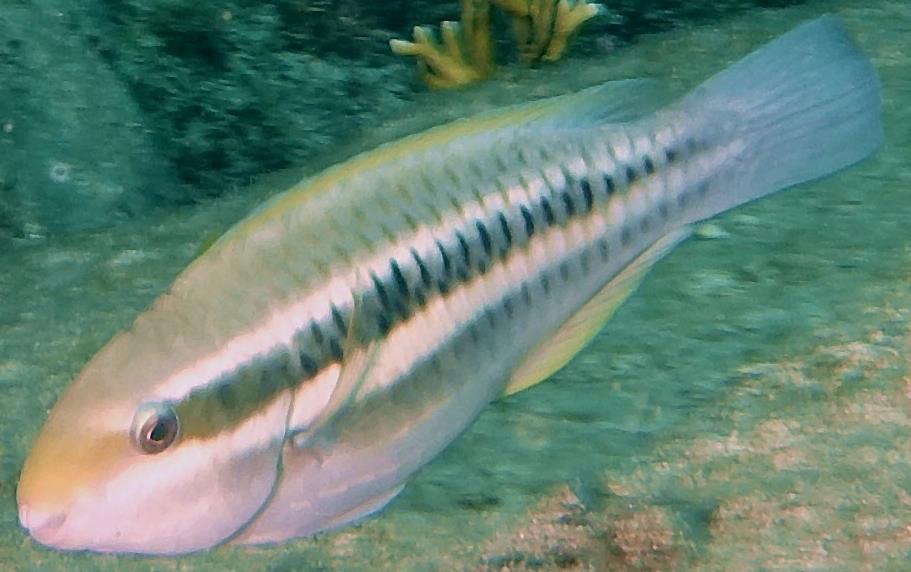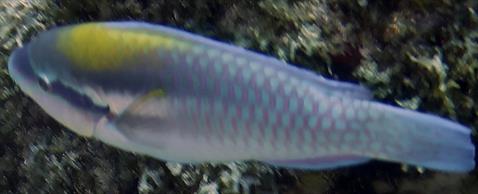



Scarus iseri
| Ecological Descriptors |
||||
| Habitat | Size (cm) | Diet | Behaviour | Sex |
| Co, S | 35 | Veg, Cor | I, Ter (Sh) | PGH |
General:
Parrotfish owe their name to the shape of their mouth. Instead of teeth they have two beak-like plates, like parrots. They have even rows of large, noticeable scales on their bodies. The development of parrotfishes is complex and accompanied by a series of changes in color (polychromatism). Individuals usually mature as females or males (Initial Phase), with some females later changing to the male sex (Terminal Phase). Large robust scales are prominent.
Description:
Terminal phase: Body blue to green, with a gold to yellow/ pale spot/ stripe above and behind the pectoral fin. Dorsal fin with a distinct pink, yellow or orange stripe down the middle that is broken by blue to green linear markings. Tail blue or green, possibly with yellow or orangish linear markings between the borders, but no blue/ pink stripes top/ bottom (cf Princess Parrotfish)
Initial and Juvenile phases: Body with three black stripes, two white stripes and a white belly, often with thin, broken silver, yellow or dark stripes. Usually yellow smudge on the nose, occasionally with yellow on the pelvic fins (possibly indicates female), belly or tail. Tail without dark margins, cf Princess Parrotfish.
Ecology
This species is reef and seagrass associated from 3 to 30 m. It is found in shallow clear reefs and seagrass (Thalassia) beds. It forms schools and feeds on algae.
Life Cycle:
It is a protogynous hermaphrodite, terminal males spawning individually with striped females, while sexually mature males in the striped phase spawn in aggregation. Juveniles are found on seagrass beds. Fertilization occurs externally, with eggs released into the open water, then fertilized by the sperm. Eggs hatch within about 25 hours of fertilization.
Most eggs hatch as female in the initial stages; a few juvenile males still exist however. As the fish develop, some females change sex to terminal males; if the male in their group dies, the largest female changes into a male.
Remarks:
Initial and juvenile phases of the Striped Parrotfish often mix with similar age Princess Parrotfish (Scarus taeniopterus). Striped parrotfish can be distinguished by the lack of dark borders on the tail.
Parrotfish owe their name to the shape of their mouth. Instead of teeth they have two beak-like plates, like parrots. They have even rows of large, noticeable scales on their bodies. The development of parrotfishes is complex and accompanied by a series of changes in color (polychromatism). Individuals usually mature as females or males (Initial Phase), with some females later changing to the male sex (Terminal Phase). Large robust scales are prominent.
Description:
Terminal phase: Body blue to green, with a gold to yellow/ pale spot/ stripe above and behind the pectoral fin. Dorsal fin with a distinct pink, yellow or orange stripe down the middle that is broken by blue to green linear markings. Tail blue or green, possibly with yellow or orangish linear markings between the borders, but no blue/ pink stripes top/ bottom (cf Princess Parrotfish)
Initial and Juvenile phases: Body with three black stripes, two white stripes and a white belly, often with thin, broken silver, yellow or dark stripes. Usually yellow smudge on the nose, occasionally with yellow on the pelvic fins (possibly indicates female), belly or tail. Tail without dark margins, cf Princess Parrotfish.
Ecology
This species is reef and seagrass associated from 3 to 30 m. It is found in shallow clear reefs and seagrass (Thalassia) beds. It forms schools and feeds on algae.
Life Cycle:
It is a protogynous hermaphrodite, terminal males spawning individually with striped females, while sexually mature males in the striped phase spawn in aggregation. Juveniles are found on seagrass beds. Fertilization occurs externally, with eggs released into the open water, then fertilized by the sperm. Eggs hatch within about 25 hours of fertilization.
Most eggs hatch as female in the initial stages; a few juvenile males still exist however. As the fish develop, some females change sex to terminal males; if the male in their group dies, the largest female changes into a male.
Remarks:
Initial and juvenile phases of the Striped Parrotfish often mix with similar age Princess Parrotfish (Scarus taeniopterus). Striped parrotfish can be distinguished by the lack of dark borders on the tail.
Striped Parrotfish TP
Striped Parrotfish TP
Striped Parrotfish Juvenile
Both with and without yellow smudge on nose. Note; no dark tail margins see below
Both with and without yellow smudge on nose. Note; no dark tail margins see below





69

Striped Parrotfish IP

552
554











553

